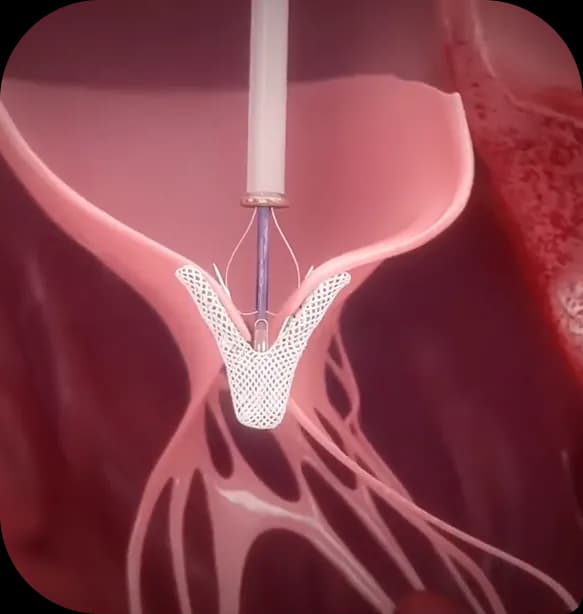
TEER Surgery/Procedure (Mitraclip/Myclip)

ABOUT
What is TEER Surgery/Procedure?
TEER, or Transcatheter Edge-to-Edge Repair, is a minimally invasive procedure in Mumbai used to treat leaky mitral valves (mitral regurgitation). Instead of open-heart surgery, TEER uses a catheter to clip the mitral valve leaflets together, reducing the backflow of blood.
Two widely used TEER devices are:
MitraClip
Used to treat mitral valve regurgitation, where the valve between the left atrium and left ventricle doesn’t close fully, causing blood to flow backward into the lungs. MitraClip is a minimally invasive TEER device that clips the valve leaflets together to reduce the leak.
MyClip
A pioneering Indian TEER device, MyClip treats mitral regurgitation similarly to MitraClip, with multiple clip angles and advanced deployment features. Heart Valve Experts (HVE) were the first to study and bring MyClip to India, performing the first human trial in the country.
Who It’s For?
Who Needs TEER Surgery/Procedure?
Severe mitral regurgitation
When the mitral valve leaks significantly and surgery isn’t an ideal option.
High-risk individuals for open-heart surgery
Elderly or medically fragile patients who can’t safely undergo major surgery.
When preserving the native valve is preferred
TEER repairs the existing valve without replacing it, making it preferable for patients where native valve function should be maintained.
Not suitable for TAVI surgery or TMVR surgery
TEER treats leaky valves, not narrowed ones like in TAVI, and avoids full replacement like TMVR.
Functional or degenerative mitral regurgitation
Caused by weak heart muscle or aging-related valve wear.

Benefits of TEER
What are the Benefits of TEER (MitraClip & TriClip)?
Minimally invasive
TEER is performed via catheter through a vein, avoiding the need for chest incisions.
Improves symptoms and heart function
TEER reduces regurgitation, significantly relieving breathlessness and fatigue.
Suitable for high-risk or elderly patients
Offers a safer alternative when open-heart surgery is too risky or not feasible.
Better tolerated in complex heart anatomy
TEER can be performed even in anatomically challenging or frail hearts.
Preserves the native heart valve
Instead of replacing the valve, it repairs and reinforces the one you have.
Improves long-term survival
Especially in younger or moderate-risk patients, TEER may delay or avoid future surgeries.
Outcomes of Procedure Delay
Risks of Delay of TEER Surgery/Procedure
- Progressive heart failure
- Worsening shortness of breath and fluid retention
- Reduced heart pumping efficiency
- Enlargement of heart chambers (ventricular dilation)
- Increased risk of hospitalization
- Higher chance of developing arrhythmias
- Decline in exercise tolerance
- Irreversible valve or heart muscle damage
- Progression to multi-valve disease


Procedure Timeline
TEER Procedure Timeline & Recovery
Day 1
Hospital admission; imaging tests (Echocardiogram, TEE,).
Day 2
TEER procedure via femoral vein catheter under conscious sedation or light anesthesia. During clip deployment, temporary blood flow changes called overload mismatch are carefully monitored with advanced imaging to ensure precise and safe placement, making the first 1–2 days of post-procedure observation crucial.
Day 3-4
Post-procedure monitoring. Patients typically start walking within 12–24 hours. Discharge with home care instructions.
Week 1–2
Home rest with limited activity. Follow-up to check valve function and clip stability via echocardiography.
Week 2-4
Gradual return to daily activities. Adjustment of heart medications if needed. Begin cardiac rehabilitation if advised.
After 1 Month
Resume full activity levels. Regular follow-ups and periodic echocardiograms used to monitor valve function and heart performance.
What Sets us Apart
Why Choose Heart Valve Experts for TEER in Mumbai?
Pioneers of MyClip in India
HVE led the first human trial of MyClip and were the first to bring this innovative TEER device to India.
Expert Team in MitraClip & MyClip
Our team of TEER specialists in Mumbai specializes in TEER using MitraClip, offering precise, minimally invasive solutions for valve regurgitation.
Advanced Imaging & 3D Echo
We use 3D TEE and fluoroscopy in a modern lab to ensure safe and accurate clip placement.
High-Risk & Elderly Patient Care
We provide tailored TEER treatment plans for patients unfit for open-heart surgery, especially seniors and those with comorbidities.
Fast Recovery with Expert Monitoring
Our recovery protocols include 1–2 days of crucial post-procedure monitoring, followed by close follow-up by our multidisciplinary team to ensure safe and effective recovery.
Trusted TEER Center in Mumbai
Led by experienced cardiologists in Mumbai, our center is known for successful outcomes and patient-first transcatheter valve repair.
Patient Success Stories
Every success story begins with the right care. Here are a few:
“Doctors performed my father’s TAVI procedure successfully and explained everything with great care. Truly grateful for his expertise and compassionate team.”
MRS. PREETI MANOHARAN
FAQs

